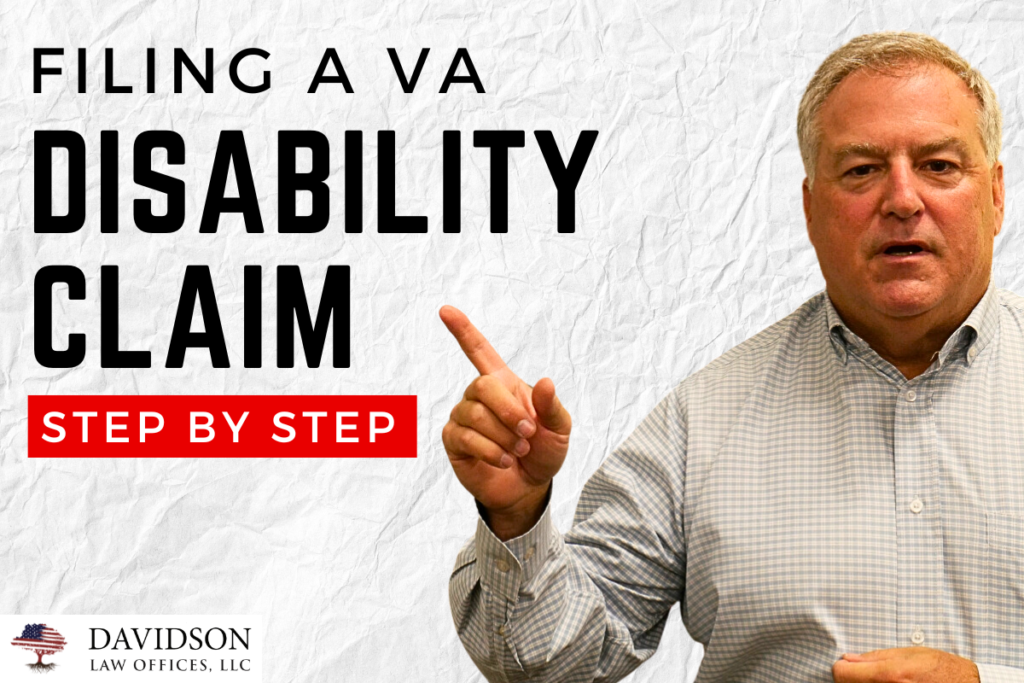Hey there, it’s Dale Davidson, the “VA Guy” here. Today, I want to talk to you about a topic that’s been on the minds of many Veterans: the VA disability claim process. If you’ve ever tried to navigate this system, you know it’s like trying to find your way through a maze—confusing, overwhelming, and often frustrating. But don’t worry; I’m here to help break down the steps for you, so you can approach this process with a bit more confidence.
Step 1: Initiating the Disability Claim
The first step in the VA disability claim process is to initiate your claim, which essentially means gathering the evidence you’ll need to support it. This is crucial because the strength of your evidence can make or break your disability claim. For example, if you’re claiming a back injury, you need to gather all relevant medical records—both from your time in service and from any private medical providers who have treated you.
Your service treatment records are vital. If you’ve been treated for your injury during your service, it should be documented there. However, if those records aren’t in your C-file (your claims file), all is not lost. You can—and should—supplement your claim with private medical records that support your case. Just make sure they are relevant to the condition you’re claiming.
One tip I always give is to organize your documents logically before you submit them. The VA is a massive organization, and your disability claim could get lost in the shuffle if it’s not clear and complete. Imagine you’re the one reviewing the disability claim—make it easy for them to see what’s what. And if possible, convince your doctor to fill out a VA Disability Benefits Questionnaire (DBQ), which can help streamline the process.
Step 2: Filing the Disability Claim
Once you’ve gathered all your evidence, the next step is to file the claim. There are several ways to do this. You can mail it in, go to your local Veteran Service Office, or use the E-Benefits portal to file electronically. I personally recommend the electronic route—it’s faster and easier to track. If you do mail it in, though, make sure you send it via certified mail. The VA has a reputation for losing things, and you don’t want your hard work to go to waste.
When you file, be thorough. Include everything—medical records, stressor statements (if you’re claiming PTSD), and any other relevant documents. The more complete your disability claim, the faster it will move through the system. The VA offers two types of claims: a fully developed claim, where you submit all the evidence up front, and a standard claim, where the VA assists in gathering evidence. The fully developed disability claim is usually faster, so if you can, go that route.
Step 3: Initial Review and Evidence Gathering
After you file, your claim goes to a claims reviewer at the VA. This is where they start to look at everything you’ve submitted. They’ll check to make sure your forms are up to date, that you’ve dotted all your i’s and crossed all your t’s. If something is missing or outdated, they’ll send it back to you. So, be meticulous from the start.
During this stage, you might be asked to undergo a Compensation and Pension (C&P) exam. This is where a VA healthcare provider or a contractor evaluates the severity of your condition and its connection to your military service. It’s crucial to be open and honest during this exam. Don’t downplay your symptoms. If your condition significantly impacts your daily life, make that clear.
Step 4: The Rating Decision
After the evidence is gathered and reviewed, the VA makes a rating decision. This determines whether your condition is service-connected and how severe it is, which in turn affects your compensation. The rating is expressed as a percentage, from 0% to 100%, in increments of 10%. This percentage determines your monthly compensation, so it’s a critical part of the process.
Step 5: Notification of Decision
Once the rating decision is made, the VA will notify you. You’ll receive a package that includes a cover letter, the rating decision, and a rating code sheet. The cover letter is a summary, and the rating decision explains how the VA reached its conclusion. This is the moment of truth—you’ll either agree with the decision or you won’t.
Step 6: Appealing the Decision
If you disagree with the VA’s decision, you have the right to appeal. There are several ways to do this: you can file a supplemental claim with new evidence, request a higher-level review, or appeal to the Board of Veterans’ Appeals. Appeals can be time-consuming, so be prepared for a long process. Sometimes, you may need the help of a Veterans Service Officer (VSO) or someone like myself to navigate this stage.
Step 7: Receiving Your Benefits
If your claim is approved, the VA will start paying your benefits, usually monthly. Depending on your rating, you might also be eligible for additional benefits like healthcare. Often, the VA will pay a lump sum for retroactive benefits, but this can sometimes come in installments.
Final Thoughts
The VA disability claim process is challenging, but it’s not impossible to navigate if you’re prepared. My best advice is to gather comprehensive evidence, organize your claim, and be thorough. And remember, you don’t have to go through this alone—there are resources and people who can help you.
Contact Us for Help!
If you need assistance with your VA disability claim, complete this form or give us a call at (229) 226-8183. If you’d like to see this blog in video format, you can watch it below. Please be sure to SUBSCRIBE to our YouTube channel and click the bell notification button so that you’re notified each time we publish a new video.

